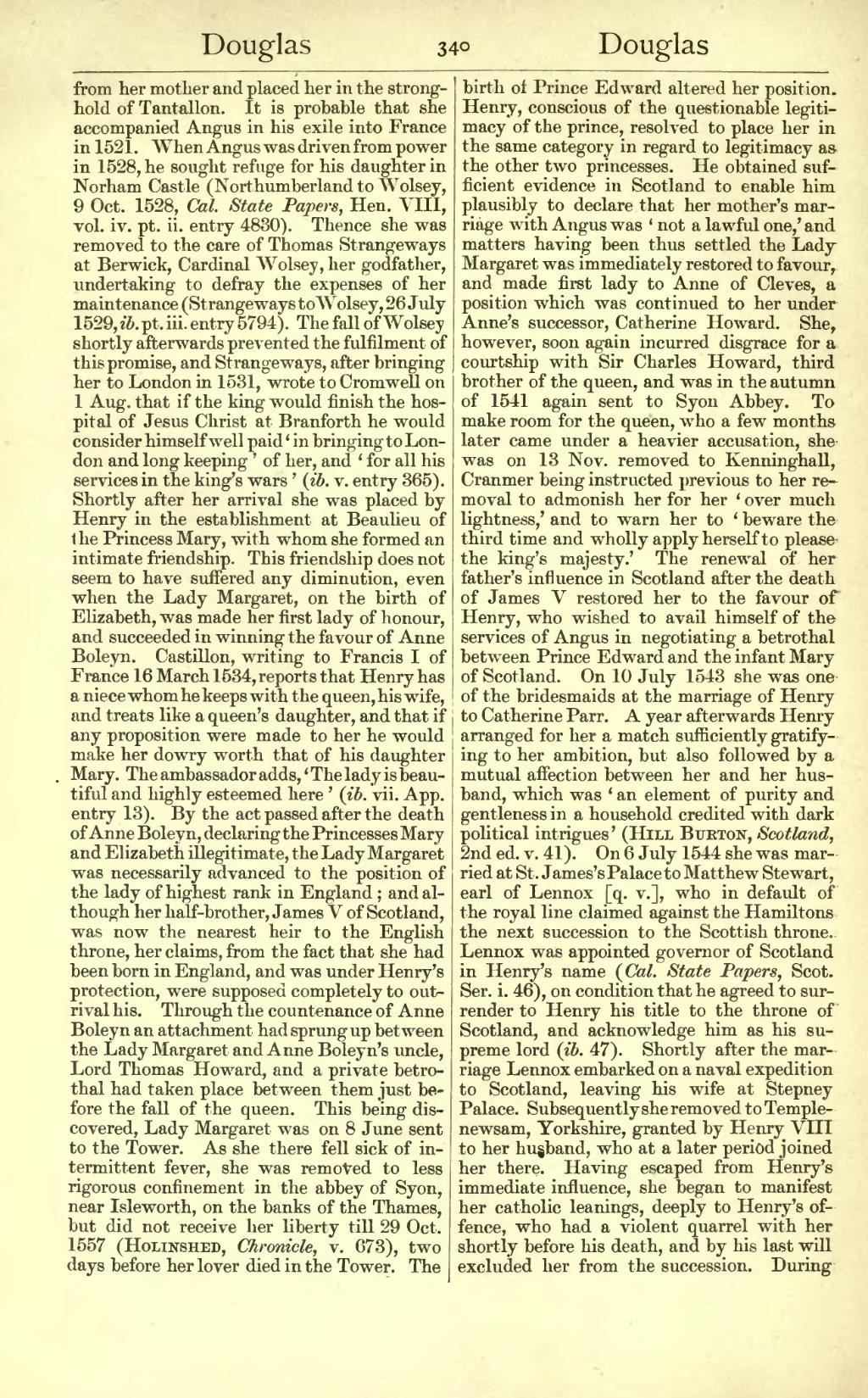from her mother and placed her in the stronghold of Tantallon. It is probable that she accompanied Angus in his exile into France in 1521. When Angus was driven from power in 1528, he sought refuge for his daughter in Norham Castle (Northumberland to Wolsey, 9 Oct. 1528, Cal. State Papers, Hen. VIII, vol. iv. pt. ii. entry 4830). Thence she was removed to the care of Thomas Strangeways at Berwick, Cardinal Wolsey, her godfather, undertaking to defray the expenses of her maintenance (Strangeways to Wolsey, 26 July 1529, ib. pt. iii. entry 5794). The fall of Wolsey shortly afterwards prevented the fulfilment of this promise, and Strangeways, after bringing her to London in 1531, wrote to Cromwell on 1 Aug. that if the king would finish the hospital of Jesus Christ at Branforth he would consider himself well paid ‘in bringing to London and long keeping’ of her, and ‘for all his services in the king's wars’ (ib. v. entry 365). Shortly after her arrival she was placed by Henry in the establishment at Beaulieu of the Princess Mary, with whom she formed an intimate friendship. This friendship does not seem to have suffered any diminution, even when the Lady Margaret, on the birth of Elizabeth, was made her first lady of honour, and succeeded in winning the favour of Anne Boleyn. Castillon, writing to Francis I of France 16 March 1534, reports that Henry has a niece whom he keeps with the queen, his wife, and treats like a queen's daughter, and that if any proposition were made to her he would make her dowry worth that of his daughter Mary. The ambassador adds, ‘The lady is beautiful and highly esteemed here’ (ib. vii. App. entry 13). By the act passed after the death of Anne Boleyn, declaring the Princesses Mary and Elizabeth illegitimate, the Lady Margaret was necessarily advanced to the position of the lady of highest rank in England; and although her half-brother, James V of Scotland, was now the nearest heir to the English throne, her claims, from the fact that she had been born in England, and was under Henry's protection, were supposed completely to outrival his. Through the countenance of Anne Boleyn an attachment had sprung up between the Lady Margaret and Anne Boleyn's uncle, Lord Thomas Howard, and a private betrothal had taken place between them just before the fall of the queen. This being discovered, Lady Margaret was on 8 June sent to the Tower. As she there fell sick of intermittent fever, she was removed to less rigorous confinement in the abbey of Syon, near Isleworth, on the banks of the Thames, but did not receive her liberty till 29 Oct. 1537 (Holinshed, Chronicle, v. 673), two days before her lover died in the Tower. The birth of Prince Edward altered her position. Henry, conscious of the questionable legitimacy of the prince, resolved to place her in the same category in regard to legitimacy as the other two princesses. He obtained sufficient evidence in Scotland to enable him plausibly to declare that her mother's marriage with Angus was ‘not a lawful one,’ and matters having been thus settled the Lady Margaret was immediately restored to favour, and made first lady to Anne of Cleves, a position which was continued to her under Anne's successor, Catherine Howard. She, however, soon again incurred disgrace for a courtship with Sir Charles Howard, third brother of the queen, and was in the autumn of 1541 again sent to Syon Abbey. To make room for the queen, who a few months later came under a heavier accusation, she was on 13 Nov. removed to Kenninghall, Cranmer being instructed previous to her removal to admonish her for her ‘over much lightness,’ and to warn her to ‘beware the third time and wholly apply herself to please the king's majesty.’ The renewal of her father's influence in Scotland after the death of James V restored her to the favour of Henry, who wished to avail himself of the services of Angus in negotiating a betrothal between Prince Edward and the infant Mary of Scotland. On 10 July 1543 she was one of the bridesmaids at the marriage of Henry to Catherine Parr. A year afterwards Henry arranged for her a match sufficiently gratifying to her ambition, but also followed by a mutual affection between her and her husband, which was ‘an element of purity and gentleness in a household credited with dark political intrigues’ (Hill Burton, Scotland, 2nd ed. v. 41). On 6 July 1544 she was married at St. James's Palace to Matthew Stewart, earl of Lennox [q. v.], who in default of the royal line claimed against the Hamiltons the next succession to the Scottish throne. Lennox was appointed governor of Scotland in Henry's name (Cal. State Papers, Scot. Ser. i. 46), on condition that he agreed to surrender to Henry his title to the throne of Scotland, and acknowledge him as his supreme lord (ib. 47). Shortly after the marriage Lennox embarked on a naval expedition to Scotland, leaving his wife at Stepney Palace. Subsequently she removed to Templenewsam, Yorkshire, granted by Henry VIII to her husband, who at a later period joined her there. Having escaped from Henry's immediate influence, she began to manifest her catholic leanings, deeply to Henry's offence, who had a violent quarrel with her shortly before his death, and by his last will excluded her from the succession. During
